Justin Taylor's Blog, page 238
February 10, 2012
How Christians Should View the Law of God
Tim Keller, reflecting on 1 Corinthians 9:21—along with Romans 6:15 and Galatians 3:10-11—writes that though the Christian "is not 'under' the law (as a way to earn salvation) he now is freed to see the beauties of God's law as fulfilled in Christ, and submits to it as way of loving his Savior."
I would want to tweak the first part of this just a bit. I think "under the law" should be glossed as "under the old age of redemptive history where the Mosaic law covenant was in effect." However, those who want to "turn back the clock on redemptive history" do subjectively end up depending on the law for salvation, so I think Keller's reading here is ultimately legitimate.
In the article Keller goes on to outline six ways that Christians relate to the law:
We embrace the law of God in order to learn more about who our God really is.
We embrace the law of God in order to discover our true selves.
We understand the law of God as fulfilled in Christ.
We realize that the law's painful, convicting work is ultimately a gracious thing.
We turn to the law of God in order to get a true definition of what it means to love others in our relationships and in society as a whole.
We turn to the law of God because sometimes we need to do things just because God says so.
You can read the whole thing here.
A Film on Charles Spurgeon
An hour-long docu-drama on the life of C. H. Spurgeon: The People's Preacher:
February 9, 2012
What Can You Do in 5 Minutes?
You can read and pray over the World Watch List of 50 countries where the church is persecuted. (HT: Z)
Michael Horton writes:
Newsweek's current cover-story is "The Global War on Christians in the Muslim World," by Ayann Hirsi Ali, who fled her native Somalia and served in the Dutch Parliament before taking a position at the American Enterprise Institute. As the article points out, widespread anti-Christian violence is exploding even in countries with Muslim minorities. How do we respond wisely as Christians to this growing threat?
Horton goes on to give three actions we can take and work for: (1) prayer; (2) faithful witness; (3) human rights, not just Christian rights. You can read the whole thing here.
Different Ways that Paul Uses "Law"
A helpful schema from Douglas J. Moo's "'Law,' 'Works of the Law' and Legalism in Paul," Westminster Theological Journal 45 (1983): 76:
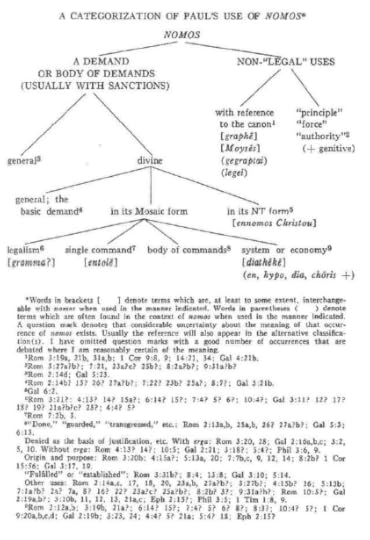
Christian Civil Disobedience against the U. S. Government?
I'm not a Catholic but I stand in 100% solidarity with my brothers & sisters to practice their belief against govt pressure [...]
I'd go to jail rather than cave in to a government mandate that violates what God commands us to do. Would you? Acts 5:29.
We have come to the point—I say this very soberly—when if there isn't a dramatic change is circumstances, we as Christians may well be called upon to stand in civil disobedience against the actions of our own government. That would break my heart as a former Marine Captain loving my country, but I love my God more. . . . I've made up my mind—sober as that decision would have to be—that I will stand for the Lord regardless of what my state tells me.
Timothy George, with Chuck Colson:
Many bishops have already declared that they will not obey this unjust law. The penalty for such a move would be severe. Catholic hospitals, universities, and other organizations would be forced to pay punitive fines ($2,000 per employee) for refusing to purchase insurance that violates the teaching of their church.
For some institutions, it would spell the end of their existence—and their far-reaching service to the public and the needy.
But Catholic institutions aren't the only ones affected by this mandate. Prison Fellowship, for example, which employs 180 people, could not purchase insurance for its employees that covers abortifacients. Nor could the world's largest Christian outreach to prisoners and their families afford the fines we would incur. . . .
We would urge you, therefore, to raise your voice against this unjust mandate that violates our first freedom as Americans. . . . We do not exaggerate when we say that this is the greatest threat to religious freedom [in the US] in our lifetime.
HT: Denny Burk
A History of the Whole World: For Kids and Adults
Susan Wise Bauer has done wonderful work writing on the history of the whole world.
She has written a four-volume narrative history of the world for elementary-school kids receiving a classical education (our kids are using them and enjoying them), and she is halfway through a substantial four-volume history of the world for adults (which advanced high school students could use as well).
Below is a description of each book published thus far:
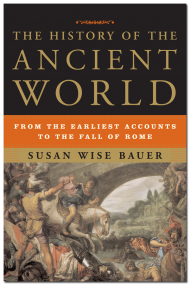 The History of the Ancient World: From the Earliest Accounts to the Fall of Rome
The History of the Ancient World: From the Earliest Accounts to the Fall of Rome
A lively and engaging narrative history showing the common threads in the cultures that gave birth to our own.
This is the first volume in a bold new series that tells the stories of all peoples, connecting historical events from Europe to the Middle East to the far coast of China, while still giving weight to the characteristics of each country. Susan Wise Bauer provides both sweeping scope and vivid attention to the individual lives that give flesh to abstract assertions about human history.
Dozens of maps provide a clear geography of great events, while timelines give the reader an ongoing sense of the passage of years and cultural interconnection. This narrative history employs the methods of "history from beneath"—literature, epic traditions, private letters and accounts—to connect kings and leaders with the lives of those they ruled. The result is an engrossing tapestry of human behavior from which we may draw conclusions about the direction of world events and the causes behind them.
896 pages, 13 illustrations, 80 maps
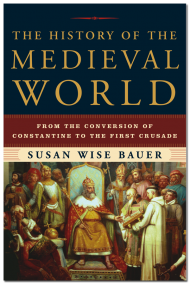 The History of the Medieval World: From the Conversion of Constantine to the First Crusade
The History of the Medieval World: From the Conversion of Constantine to the First Crusade
A masterful narrative of the Middle Ages, when religion became a weapon for kings all over the world.
From the schism between Rome and Constantinople to the rise of the T'ang Dynasty, from the birth of Muhammad to the crowning of Charlemagne, this erudite book tells the fascinating, often violent story of kings, generals, and the peoples they ruled.
In her earlier work, The History of the Ancient World, Susan Wise Bauer wrote of the rise of kingship based on might. But in the years between the fourth and the twelfth centuries, rulers had to find new justification for their power, and they turned to divine truth or grace to justify political and military action. Right thus replaces might as the engine of empire.
Not just Christianity and Islam but the religions of the Persians and the Germans, and even Buddhism, are pressed into the service of the state. This phenomenon—stretching from the Americas all the way to Japan—changes religion, but it also changes the state.
746 pages, 4 illustrations, 46 maps
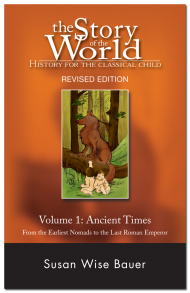
Volume 1: Ancient Times: From the Earliest Nomads to the Last Roman Emperor
What terrible secret was buried in Shi Huangdi's tomb? Did nomads like lizard stew? What happened to Anansi the Spider in the Village of the Plantains? And how did a six-year-old become the last emperor of Rome?
Told in a straightforward, engaging style that has become Susan Wise Bauer's trademark, The Story of the World series covers the sweep of human history from ancient times until the present. Africa, China, Europe, the Americas—find out what happened all around the world in long-ago times. This first revised volume begins with the earliest nomads and ends with the last Roman emperor. Newly revised and updated, The Story of the World, Volume 1 includes maps, a new timeline, more illustrations, and additional parental aids. This read-aloud series is designed for parents to share with elementary-school children. Enjoy it together and introduce your child to the marvelous story of the world's civilizations.
Volume 1 Grade Recommendation: Grades 1-5. Illustrated throughout with black-and-white drawings and maps
22-page sample PDF
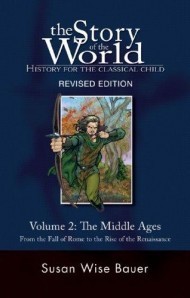 Volume 2: The Middle Ages: From the Fall of Rome to the Rise of the Renaissance
Volume 2: The Middle Ages: From the Fall of Rome to the Rise of the Renaissance
Now more than ever, other cultures are affecting our everyday lives—and our children need to learn about the other countries of the world and their history. Susan Wise Bauer has provided a captivating guide to the history of other lands. Written in an engaging, straightforward manner, this revised edition of The Story of the World: History for the Classical Child, Volume 2: The Middle Ages weaves world history into a story book format. Who discovered chocolate? What happened to the giant Fovor of the Mighty Blows? Why did the Ottoman Turks drag their war ships across dry land?
The Story of the World covers the sweep of human history from ancient times until the present. Africa, China, Europe, the Americas—find out what happened all around the world in long-ago times. Designed as a read-aloud project for parents and children to share together, The Story of the World includes each continent and major people group. Volume 2: The Middle Ages, is the second of a four-volume series and covers the major historical events in the years 400 to 1600 CE, as well as including maps, illustrations, and tales from each culture.
Volume 2 Grade Recommendation: Grades 1-6. Illustrated throughout with black-and-white drawings and maps
19-page sample PDF
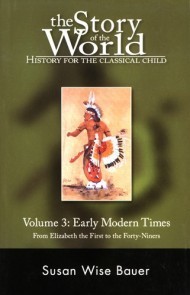 Volume 3: Early Modern Times: From Elizabeth the First to the Forty-Niners
Volume 3: Early Modern Times: From Elizabeth the First to the Forty-Niners
Now more than ever, other cultures are affecting our everyday lives—and our children need to learn about the other countries of the world and their history. Susan Wise Bauer has provided a captivating guide to the history of other lands. Written in an engaging, straightforward manner, The Story of the World: History for the Classical Child; Volume 3: Early Modern Times weaves world history into a story book format. Who was the Sun King? Why did the Luddites go around England smashing machines? And how did samurai become sumo wrestlers?
The Story of the World covers the sweep of human history from ancient times until the present. Africa, China, Europe, the Americas—find out what happened all around the world in long-ago times. Designed as a read-aloud project for parents and children to share together, The Story of the World includes each continent and major people group. Volume 3: Early Modern Times is the third of a four volume series and covers the major historical events in the years 1600 to 1850, as well as including maps, illustrations, and tales from each culture.
Volume 3 Grade Recommendation: Grades 3-8. Illustrated throughout with black-and-white drawings and maps
16-page sample PDF
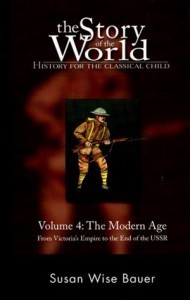 Volume 4: The Modern Age: From Victoria's Empire to the End of the USSR
Volume 4: The Modern Age: From Victoria's Empire to the End of the USSR
Where was the Crystal Palace? Who was the Sick Man of Europe? And how did cow fat start a revolution?
Now more than ever, other countries and customs affect our everyday lives—and our children need to learn about the people who live all around the world. Susan Wise Bauer has provided a captivating guide to the history of modern nations all around the world. Written in an engaging, straightforward manner, the final volume of the popular Story of the World series weaves world history into a storybook format, covering major historical events in the years 1850-2000. From the Middle East and China to Africa and the Americas—find out what happened all around the world in the last century and a half. Designed as a read-aloud project for parents and children to share together, The Story of the World includes the stories of each continent and people group.
Volume 4 Grade Recommendation: Grades 3-8. Illustrated throughout with black-and-white drawings and maps
36-page sample PDF
The links above are to the caseside hardback versions, but you can also get them as paperbacks: volume 1, volume 2, volume 3, and volume 4.
The audio CDs of this book are very well done, too. It's narrated by the entertaining Jim Weiss. You can get volume 1, volume 2, volume 3, and volume 4.
February 8, 2012
A Production of Hamlet That Finally Makes Sense
T.S. Elliot once suggested that Shakespeare's Hamlet doesn't make a whole lot of sense, and is ultimately "a flop."
But Edward T. Oakes argues that with the release of the Royal Shakespeare Company's Hamlet (first on stage, then on the BBC and PBS, and now on DVD), "here is a Hamlet that finally makes sense." He says it is "by far the freshest and most arresting interpretation I have ever seen of the play." David Tennant stars as Hamlet and Patrick Stewart as Claudius.
"To my mind," he writes, "the success of this new RSC production stems from a host of factors, all of which work together in such a way that, pace Eliot, the play now finally makes sense."
Here are his points in outline:
First of all, each line is so freshly delivered that it sounds new (quite a feat for this play!). . . .
Second (and this is a negative virtue), this production eschews any Freudian interpretation, which by now has become an empty cliché, and even an embarrassment. . . .
Third, the setting of the play is the contemporary national-security state, with CCTV cameras everywhere, and from whose tapes we see some of the action (interestingly, the ghost's outline does not register on the tapes). As world literature's most famous neurotic, Hamlet's unstable personality is already sufficiently known by almost any audience; but in this production there is an added reason for Hamlet's incipient madness besides his own volatile temper. . . .
Fourth, the soliloquies are not treated as the dramaturgical equivalent of operatic arias, but flow naturally out of the action. . . .
Which brings me to the fifth and last great merit of this version: here Hamlet truly displays the dilemmas of his personality. It is one of the great mysteries of this play how Shakespeare manages to get the audience to sympathize with his protagonist. . . .
Read the whole thing for more detailed interaction with this new version.
You can watch the whole three-hour production online for free.
A Conflict of Visions: Or, Why Can't We All Get Along?

I suspect that Thomas Sowell's classic work, Conflict of Visions: Ideological Origins of Political Struggles (2002), may be one of the most important books that Christians today can read for help in thinking through worldview clashes and political partisanship. It is an illuminating, even-handed book—not written for purposes of advocacy, and not written from an explicitly Christian perspective, but written to help us understand some of the main contours of why there tend to be roughly two visions of the world when it comes to freedom, power, equality, justice, knowledge, and man.
The big idea in the first paragraph of this book may seem obvious to you, but when I first read this some years ago, it was enormously illuminating to me:
One of the curious things about political opinions is how often the same people line up on opposite sides of different issues. The issues themselves may have no intrinsic connection with each other. They may range from military spending to drug laws to monetary policy to education. Yet the same familiar faces can be found glaring at each other from opposite sides of the political fence, again and again. It happens too often to be coincidence and it is too uncontrolled to be a plot.
A closer look at the arguments on both sides often shows that they are reasoning from fundamentally different premises. These different premises—often implicit—are what provide the consistency behind the repeated opposition of individuals and groups on numerous, unrelated issues. They have different visions of how the world works.
Why, at the end of the day, do we have such a hard time understanding one another across the political divide? Why can't we find middle ground? As Rodney King asked, Why can't we all just get along? Sowell identifies a key part of the problem:
Whatever one's vision, other visions are easily misunderstood—not only because of caricatures produced by polemics but also because the very words used ("equality," "freedom," "justice," "power") mean entirely different things in the context of different presuppositions. It is not mere misunderstanding but the inherent logic of each vision which leads to these semantic differences, as well as to substantively different conclusions across a wide spectrum of issues. Visions are inherently in conflict, quite aside form the misunderstandings, hostilities, or intransigence generated in the course of polemics. (pp. 245-246)
Sowell recognizes that there is a continuum of social visions—that sense of how the world works and the foundation upon which our theories are built. But for convenience, he identifies two broad and irreconcilable categories: the constrained vision and the unconstrained vision. Sowell identifies their basic difference as stemming from a different conception of the nature of man. So in successive chapters he looks at the constrained vs. unconstrained vision of the nature of man, the nature of knowledge, and the nature of social processes.
Let's look at an example. The way in which the unconstrained vision thinks about "results" determines the ways in which its advocates define and analyze key concepts like freedom, power, and equality. If results can be directly prescribed, and if basic concepts are expressed in terms of results, then we get something like the following:
The degree of freedom is . . . the degree to which one's desires can be realized, without regard to whether the obstacles to full realization be the deliberately imposed restrictions of government or the lack of circumstantial prerequisites.
Power is likewise defined by results: If A can cause B to do what A wants done, then A has power over B, regardless of whether A's inducements to B are positive (rewards) or negative (penalties).
Equality too is a result, the degree of equality or inequality being a direct observable fact. (pp. 246-247)
All these basic terms are defined in profoundly different ways under the assumptions of the constrained vision. In that vision, man cannot directly create social results, but he can create social processes. Therefore, for the constrained visions basic concepts like freedom, justice, power, and equality get their significance and character from processes, whereas the unconstrained vision (as we saw) thinks of them mainly in terms of results. For example, in the constrained vision:
A social process has freedom to the extent that it refrains from interfering with the choices of individuals—whether or not the circumstances of those individuals provide them with many options or few.
A social process has justice to the extent that its rules are just, regardless of the variety of outcomes resulting from the application of those rules.
Power is exerted in social processes, by individuals or by institutions, to the extent that someone's existing set of options is reduced—but is not an exertion of power to offer a quid pro quo that adds to his existing options.
Equality as a process characteristic means application of the same rules to all, without regard to individual antecedent conditions or subsequent results. (p. 247)
Sowell wisely writes:
The clash between the two visions is not over the actual or desirable degree of freedom, justice, power, or equality—or over the fact that that there can only be degrees and not absolutes—but rather over what these things consist of, in whatever degree they occur.
Sowell is one of the most eloquent advocates today for the constrained vision, but in this book he plays it straight, choosing to explain rather than to persuade. As such, it is not a Christian book per se, analyzing the various options in light of God's word written. But I would still submit that it may be one of the most important books a Christian can read to understand what is going on in today's culture when it comes to political struggles.
[Emphasis added in quotes.]
Want to Learn Latin?
You can get four introductory lessons and two regular lessons here. If you decide to purchase the additional lessons, you can use the coupon code BTWLATIN to get a 15% discount. The code is good for one week from today.
Descriptions below of the free material:
These four introductory lessons provide background and tools for learning Latin. They are intended to be watched before starting Visual Latin and are different from the normal teaching lessons.
The 2 free regular lessons are Lessons 1 & 2 of Visual Latin. Test them out with your children to see if they like them. We think they will.
Lesson A | Why Study Latin? – This first introductory lesson tells you what to say when people ask you why you're studying a dead language. (Length: 11:08 min)
Lesson B | Latin Then & Now - Where did Latin come from anyway? And what happened to it after the Romans disappeared? Furthermore, does it have a future? (Length: 8:07 min)
Lesson C | How to Learn a Language - This lesson gives you techniques, ideas and a few tricks for learning any new language (and especially Latin). (Length: 8:43 min)
Lesson D | Stuff You Should Know About Latin – Latin does some funny things. You'll need to know what to watch for so you don't slip and hurt yourself. (Length: 6:47 min)
* * *
Lesson 1 | Being Verb Basics – To Be and Not To Be
Lesson 2 | Being Verb Basics – Predicate Nominatives and Adjectives
Here are a couple of video previews:
February 7, 2012
Keller on NYC Schools' Decision to Ban Churches
I am grieved that New York City is planning to take the unwise step of removing 68 churches from the spaces that they rent in public schools. It is my conviction that those churches housed in schools are invaluable assets to the neighborhoods that they serve. Churches have long been seen as positive additions to communities. Family stability, resources for those in need, and compassion for the marginalized are all positive influences that neighborhood churches provide. There are many with first-hand experience who will claim that the presence of churches in a neighborhood can lead to a drop in crime.
The great diversity of our city means that we will never all agree completely on anything. And we cherish our city's reputation for tolerance of differing opinions and beliefs. Therefore, we should all mourn if disagreement with certain beliefs of the church is allowed to unduly influence the formation of just policy and practice.
I disagree with the opinion written by Judge Pierre Leval that: "A worship service is an act of organized religion that consecrates the place in which it is performed, making it a church." This is an erroneous theological judgment; I know of no Christian church or denomination that believes that merely holding a service in a building somehow "consecrates" it, setting it apart from all common or profane use. To base a legal opinion on such a superstitious view is surely invalid. Conversely, I concur with Judge John Walker's dissenting opinion that this ban constitutes viewpoint discrimination and raises no legitimate Establishment Clause concerns.
A disproportionate number of churches that are affected by this prohibition are not wealthy, established communities of faith. They are ones who possess the fewest resources and many work with the poor. Redeemer has many ties with those churches and their pastors, and our church community invests time and resources to assist them to be good neighbors in their communities.
Let them be those good neighbors. I am hopeful that the leaders of New York City and the legislators of New York State will see the value of a society that encourages all spheres of culture—the church, government, education, business, etc—to work together for human flourishing.
HT: Z
Justin Taylor's Blog
- Justin Taylor's profile
- 44 followers



